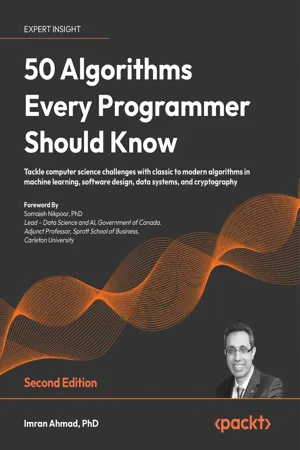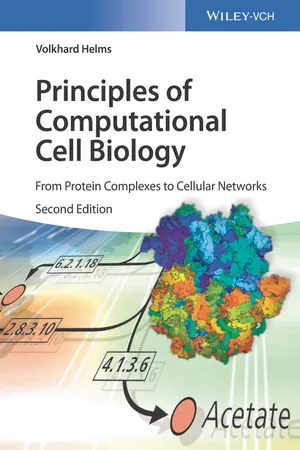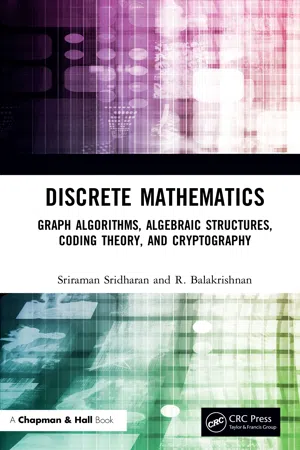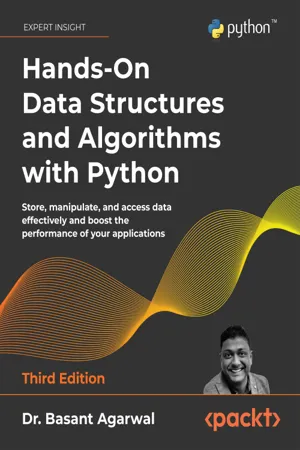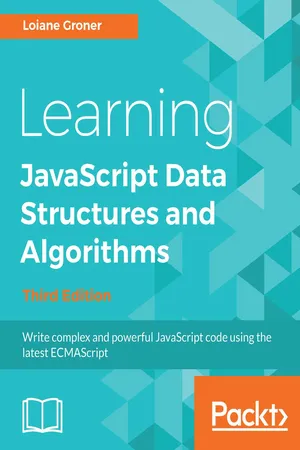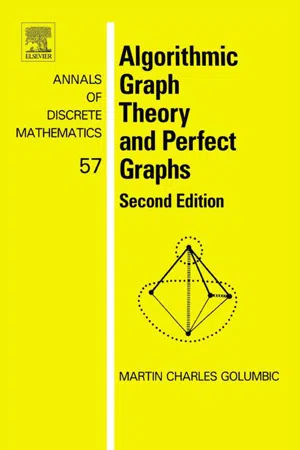Computer Science
Graph Algorithms
Graph algorithms are a set of techniques used to solve problems related to graphs, which are structures consisting of nodes and edges. These algorithms are used to traverse, search, and manipulate graphs to solve various computational problems. They are fundamental in computer science and are applied in diverse areas such as network routing, social network analysis, and recommendation systems.
Written by Perlego with AI-assistance
Related key terms
6 Key excerpts on "Graph Algorithms"
- eBook - ePub
50 Algorithms Every Programmer Should Know
An unbeatable arsenal of algorithmic solutions for real-world problems
- Imran Ahmad(Author)
- 2023(Publication Date)
- Packt Publishing(Publisher)
5
Graph Algorithms
Graphs offer a distinct way to represent data structures, especially when compared to structured or tabular data. While structured data, such as databases, excel at storing and querying static, uniform information, graphs shine in capturing intricate relationships and patterns that exist among entities. Think of Facebook, where every user is a node, and each friendship or interaction becomes a connecting edge; this web of connections can be best represented and analyzed using graph structures.In the computational realm, certain problems, often those involving relationships and connections, are more naturally addressed using Graph Algorithms. At their core, these algorithms aim to understand the structure of the graph. This understanding involves figuring out how data points (or nodes) connect via links (or edges) and how to effectively navigate these connections to retrieve or analyze the desired data.In this chapter, we’ll embark on a journey through the following territories:- Graph representations : Various ways to capture graphs.
- Network theory analysis : The foundational theory behind network structures.
- Graph traversals : Techniques to efficiently navigate through a graph.
- Case study : Delving into fraud analytics using Graph Algorithms.
- Neighborhood techniques : Methods to ascertain and analyze localized regions within larger graphs.
Upon completion, we will have a robust grasp of graphs as data structures. We should be able to formulate complex relationships—both direct and indirect—and will be equipped to tackle complex, real-world problems using Graph Algorithms.Understanding graphs: a brief introduction
In the vast interconnected landscapes of modern data, beyond the confines of tabular models, graph structures emerge as powerful tools to encapsulate intricate relationships. Their rise isn’t merely a trend but a response to challenges posed by the digital world’s interwoven fabric. Historical strides in graph theory, like Leonhard Euler’s pioneering solution to the Seven Bridges of Königsberg problem, laid the foundation for understanding complex relationships. Euler’s method of translating real-world issues into graphical representations revolutionized how we perceive and navigate graphs. - eBook - ePub
Principles of Computational Cell Biology
From Protein Complexes to Cellular Networks
- Volkhard Helms(Author)
- 2018(Publication Date)
- Wiley-VCH(Publisher)
Search and enumeration. Many problems (such as a chess game) can be tackled by constructing a corresponding search problem on a mathematical graph. Algorithms to explore graphs define rules how the graph may be searched.Probabilistic and heuristic algorithms. This class of algorithms is quite diverse.- Probabilistic algorithms make some random choices during the execution.
- Genetic algorithms try to solve a given problem by mimicking biological evolutionary processes. Typically, these are iterative algorithms where random mutations among the current “solutions” generate the next generation of “solutions.” In this manner, genetic algorithms implement the biological concepts of reproduction and “survival of the fittest.” We will see an example of this type in Section 14.5 .
- Heuristic algorithms. The general purpose of such algorithms is not to identify an optimal solution. They are employed when the computing time or memory requirements to find an optimal solution is beyond manageable bounds. Instead, heuristic algorithms construct an approximate solution in a reasonable time.
Figure 4.4 Two popular ways to store connectivity information. (a) The first array contains pointers to the proteins interacting with protein 1, the second array contains the interaction partners of protein 2, etc. (b) An n × n matrix contains values of “1” for interacting proteins and values of “0” for those where no interactions were recorded.4.3 Data Structures for Graphs
As introduced in Section 4.1 , a graph is an abstract data structure. A graph is formed by a set of vertices and a set of edges. The edges represent relationships (connections) between the vertices. In typical implementations of graphs, vertices are implemented as structures or objects. Edges can be realized in several ways. Each of them has its own advantages and disadvantages. One strategy is an adjacency list. This “list” essentially consists of an array of vertices that are associated with incident edges (Figure 4.4 ). If information is only stored in vertices, not in edges (i.e. it is not a weighted graph), a row simply contains the indices of the vertices to which the row vertex is connected to. In this way, edges can be represented in a memory saving fashion. A favorable property of this realization is that it is straightforward to add new vertices to the graph. They can be linked to existing vertices simply by adding elements to the appropriate arrays. On the other hand, it takes O(n) time to find out whether two given vertices are connected by an edge. Here, n - eBook - ePub
Discrete Mathematics
Graph Algorithms, Algebraic Structures, Coding Theory, and Cryptography
- Sriraman Sridharan, R. Balakrishnan(Authors)
- 2019(Publication Date)
- Chapman and Hall/CRC(Publisher)
Chapter 1 Graph Algorithms IThe aim of physical sciences is not the provision of pictures, but the discovery of laws governing the phenomena and the application of these laws to discover new phenomena. If a picture exists, so much the better. Whether a picture exists or not is only a matter of secondary importance.P. DiracIn this chapter, we study various algorithms on graphs. Unfortunately, the graphs are not manipulated by their geometrical representation inside a computer. We start with two important representations of graphs: the adjacency matrix representation and the adjacency list representation. Of course, we have to choose a representation so that the operations of our algorithm can be performed in order to minimize the number of elementary operations.After seeing how the graphs are represented inside a computer, two minimum spanning tree algorithms in a connected simple graph with weights associated to each edge, one due to Prim and the other invented by Kruskal are presented. Then, shortest path problems in a weighted directed graph are studied. First, the single-source shortest path problem due to Dijkstra is presented. As an application, an algorithm is given to test the bipartiteness of a graph. Next, a single-source shortest path algorithm for negative edge weights is given. Then, all-pairs shortest path problem due to Floyd and the transitive closure algorithm by Warshall are given. Floyd’s algorithm is applied to find eccentricities of vertices, radius and diameter of a graph.Finally, we study a well-known graph traversal technique, called depth-first search. As applications of the graph traversal method, we study the algorithms to find connected components, biconnected components, strongly connected components, topological sort and program evaluation and research technique (PERT). In the last subsection, we study the famous NP-complete problem, traveling salesman problem (TSP) and present the brute-force algorithm and two approximate algorithms. For basic properties of graphs and digraphs, the reader may see [6 - Dr. Basant Agarwal(Author)
- 2022(Publication Date)
- Packt Publishing(Publisher)
9
Graphs and Algorithms
Graphs are a non-linear data structure, in which the problem is represented as a network by connecting a set of nodes with edges, like a telephone network or social network. For example, in a graph, nodes can represent different cities while the links between them represent edges. Graphs are one of the most important data structures; they are used to solve many computing problems, especially when the problem is represented in the form of objects and their connection, e.g. to find out the shortest path from one city to another city. Graphs are useful data structures for solving real-world problems in which the problem can be represented as a network-like structure. In this chapter, we will be discussing the most important and popular concepts related to graphs.In this chapter, we will learn about the following concepts:- The concept of the graph data structure
- How to represent a graph and traverse it
- Different operations and their implementation on graphs
Graphs
A graph is a set of a finite number of vertices (also known as nodes) and edges, in which the edges are the links between vertices, and each edge in a graph joins two distinct nodes. Moreover, a graph is a formal mathematical representation of a network, i.e. a graph G is an ordered pair of a set V of vertices and a set E of edges, given as G = (V, E) in formal mathematical notation.An example of a graph is shown in Figure 9.1 :Figure 9.1: An example of a graphThe graph G = (V, E) in Figure 9.1 can be described as below:- V = {A, B, C, D, E}
- E = {{A, B}, {A, C}, {B, C}, {B, D}, {C, D}, {D, D}, {B, E}, {D, E}}
- G = (V, E)
- Node or vertex : A point or node in a graph is called a vertex. In the preceding diagram, the vertices or nodes are A , B , C , D , and E and are denoted by a dot.
- Edge : This is a connection between two vertices. The line connecting A and B
- Loiane Groner(Author)
- 2018(Publication Date)
- Packt Publishing(Publisher)
Graphs
In this chapter, you will learn about another nonlinear data structure, called graphs. This will be the last data structure we will cover before diving into sorting and searching algorithms. This chapter will cover a considerable part of the wonderful applications of graphs. Since this is a vast topic, we could write a book like this just to dive into the amazing world of graphs. In this chapter, we will cover:- Graph terminology
- Representing a graph in three different ways
- The graph data structure
- Graph search algorithms
- Shortest path algorithms
- Minimum spanning tree algorithms
Passage contains an image
Graph terminology
A graph is an abstract model of a network structure. A graph is a set of nodes (or vertices ) connected by edges . Learning about graphs is important because any binary relationship can be represented by a graph.Any social network, such as Facebook, Twitter, and Google+, can be represented by a graph. We can also use graphs to represent roads, flights, and communications, as shown in the following image: Let's learn more about the mathematical and technical concepts of graphs.A graph G = (V, E) is composed of:- V : A set of vertices
- E : A set of edges connecting the vertices in V
Vertices connected by an edge are called adjacent vertices . For example, A and B are adjacent, A and D are adjacent, A and C are adjacent, and A and E are not adjacent.A degree of a vertex consists of the number of adjacent vertices. For example, A is connected to three vertices. Therefore, A has degree 3. E is connected to two vertices. Therefore, E has degree 2.A path is a sequence of consecutive vertices, such as v1 , v2 , ..., vk , where vi and vi+1 are adjacent. Using the graph from the previous diagram as an example, we have the paths A B E I and A C D G , among others.A simple path does not contain repeated vertices. As an example, we have the path A D G . A cycle is a simple path, except for the last vertex, which is the same as the first vertex: A D C A (back to A- eBook - ePub
- Martin Charles Golumbic(Author)
- 2004(Publication Date)
- North Holland(Publisher)
Chapter 2The Design of Efficient Algorithms
Martin Charles GolumbicPublisher Summary
With the advent of the high-speed electronic computer, new branches of applied mathematics have sprouted forth. One area that has enjoyed a most rapid growth in the past decade is the complexity analysis of computer algorithms. At one level, the relative efficiencies of procedures, which solve the same problem, are compared. At a second level, one can ask whether one problem is intrinsically harder to solve than another problem. It may even turn out that a task is too hard for a computer to solve within a reasonable amount of time. Measuring the costs to be incurred by implementing various algorithms is a vital necessity in computer science, but it can be a formidable challenge. The chapter discusses the differences between computability and computational complexity. Computational complexity deals precisely with the quantitative aspects of problem solving. It addresses the issue of what can be computed within a practical or reasonable amount of time and space by measuring the resource requirements exactly or by obtaining upper and lower bounds. Complexity is actually determined on three levels: the problem, the algorithm, and the implementation.1 The Complexity of Computer Algorithms
With the advent of the high-speed electronic computer, new branches of applied mathematics have sprouted forth. One area that has enjoyed a most rapid growth in the past decade is the complexity analysis of computer algorithms. At one level, we may wish to compare the relative efficiencies of procedures which solve the same problem. At a second level, we can ask whether one problem is intrinsically harder to solve than another problem. It may even turn out that a task is too hard for a computer to solve within a reasonable amount of time. Measuring the costs to be incurred by implementing various algorithms is a vital necessity in computer science, but it can be a formidable challenge.
Learn about this page
Index pages curate the most relevant extracts from our library of academic textbooks. They’ve been created using an in-house natural language model (NLM), each adding context and meaning to key research topics.
